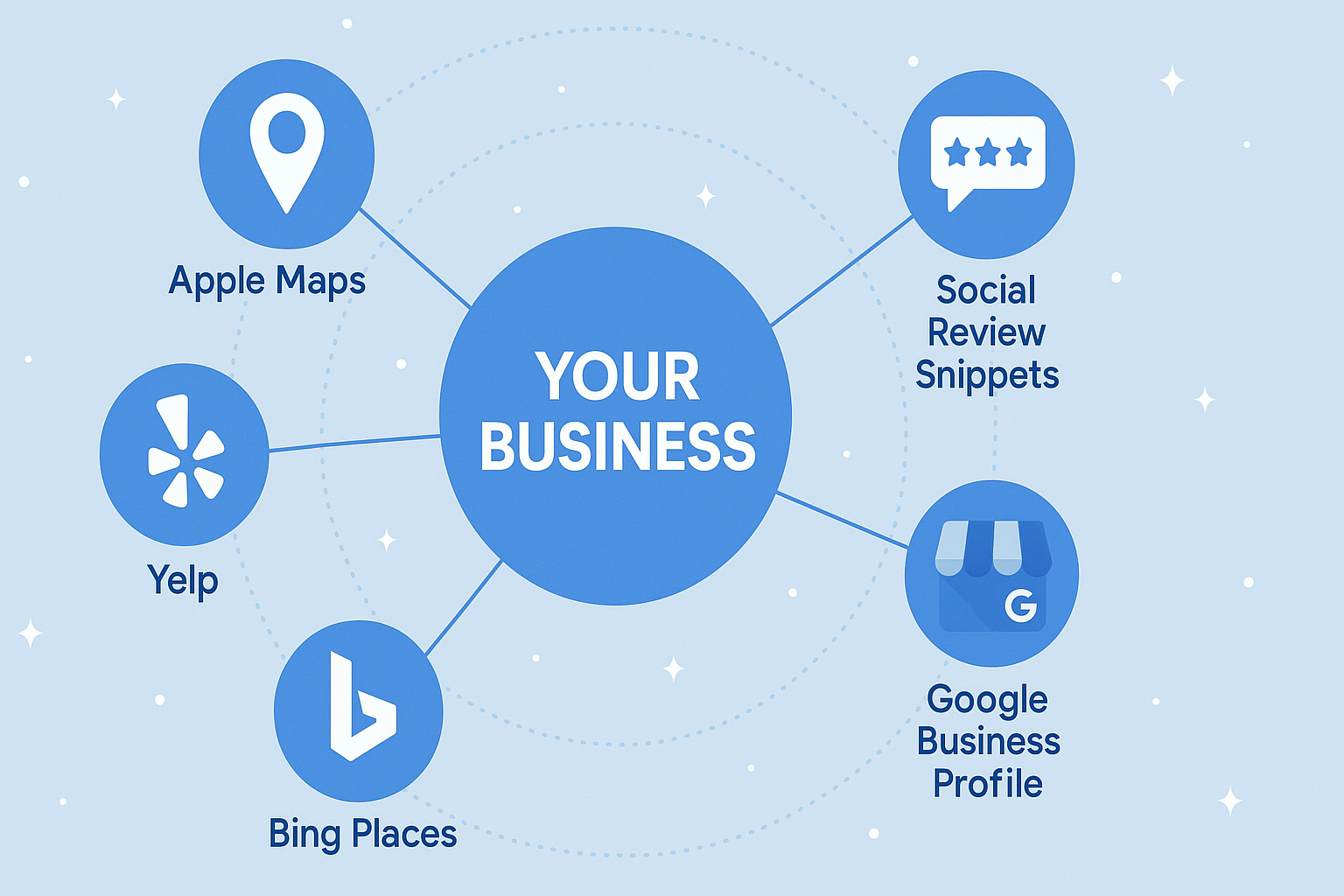When a customer picks up an iPhone, asks Siri for “hardware store near me,” or types that same query into a Windows laptop, the answer they get might never come from Google. In 2025 Apple Maps, Yelp results embedded in third-party searches, and Bing’s AI-powered local packs shape millions of buying decisions each day. Yet most small and mid-sized businesses still treat Google Business Profile as a one-and-done checkbox—leaving their storefronts practically invisible everywhere else. This guide explains why that blind spot costs sales, then shows exactly how to fix it.
Why Ranking Beyond Google Matters in 2025
Zero-click answers and AI snippets mean fewer organic clicks flow from Google than ever before, forcing brands to diversify their visibility. Apple Maps ships on every iPhone and serves roughly 500 million monthly users— all before a browser even opens. Bing’s share may seem modest, but its 8.5 percent global desktop market slice represents an audience Google can’t reach, especially inside Windows 11 and Microsoft Copilot. Meanwhile, Yelp pages keep landing among the top five organic results for transactional queries because of the platform’s towering domain authority, even when shoppers never launch the Yelp app. If your information is inconsistent—or missing—on any of these networks, algorithms hesitate to surface you, and customers simply go elsewhere.
Mastering Apple Maps with Business Connect
Apple’s free Business Connect dashboard is now far more than a place-card editor. Recent updates let owners push brand logos into iOS email headers and, soon, iPhone caller-ID screens, creating a seamless trust signal across the entire Apple ecosystem. Start by claiming every physical or service-area location. During verification, double-check NAP (name, address, phone) accuracy down to suite numbers; Maps is unforgiving about mismatches. Next, upload a high-contrast cover photo and a gallery that mirrors real customer experiences (think interior shots, staff faces, and product close-ups). Finally, enrich your profile with the Showcase feature—timed promotions or seasonal offers that appear atop your place card and inside Messages results. Apple surfaces listings with frequent Showcase updates more often in Siri suggestions, so schedule new spotlights at least once a month.
For online-only shops, Apple now supports “virtual business” cards that link directly to your e-commerce or booking flow. These listings still require a legal mailing address, but they unlock Maps and Wallet exposure without a storefront. Remember that every edit triggers a brief re-review, so batch changes to avoid downtime.
Dominating Yelp’s Evolving Algorithm
Yelp’s 2025 ranking formula values three signals above all others: a fully completed profile, a steady rhythm of authentic reviews, and visible owner engagement. Completeness means every allowable category tag, hour field, amenity, and high-resolution photo slot must be filled. Resist the temptation to keyword-stuff your business name—Yelp’s filter demotes it. Instead, weave city-level modifiers naturally into your “From the Business” description paragraph.
Review velocity matters more than sheer volume. Aim for a predictable trickle: for example, two genuine reviews per week feel more organic than twenty in one day. Train frontline staff to invite feedback at checkout with phrasing that avoids explicitly asking for five stars. Compliment each new review publicly within 48 hours. Yelp’s trust filter boosts pages where owners respond promptly, even to short or negative comments, because it signals a living business.
To convert Yelp visibility into website sessions, enable the “Call to Action” button (free in most categories) and link it to a trackable landing page. Monitor clicks in Yelp’s dashboard alongside Google Analytics UTM data to prove ROI to stakeholders.
Leveraging Bing Places for AI-Driven Discovery
The relaunched Bing Places for Business feeds not only Bing’s classic maps pack but also Outlook, Teams, Windows Widgets, and Copilot answers—touchpoints that carve their own search funnel. Listing is free and verification mirrors Google’s postcard or phone PIN workflow. After claiming, write a conversational, first-person description sprinkled with your core service keywords plus a city or neighborhood reference; the new GPT-4-powered ranking engine parses semantic context better than legacy keyword stuffing.
Because competition is lighter on Bing, small tweaks propel rankings quickly. Replace generic stock images with real storefront and team photos at 1200 × 1200 pixels; Bing’s computer-vision model rewards authenticity. Refresh holiday hours the moment they change—Microsoft flags stale listings. Finally, encourage Windows users to leave Microsoft account-verified reviews; those carry extra weight in the trust layer powering Copilot chat recommendations.
Industry best practice now emphasizes verifying identical NAP data across Google, Apple, Yelp, Bing, and niche directories to reinforce entity consistency for all engines’ AI layers.
Small-business owners juggling fulfillment, HR, and finance can’t always babysit four dashboards, but inconsistent data chips away at foot traffic every day. That’s where Vadimages steps in. Our Tampa-based development studio integrates your Apple Business Connect, Yelp, Bing Places, and Google profiles through a single custom admin panel—built on TypeScript and ready to plug into your existing CMS. Clients see an average 38 percent lift in non-Google local impressions within three months. Ready to own every map pin that matters? Book a free strategy call with Vadimages today and turn searches into store visits.
